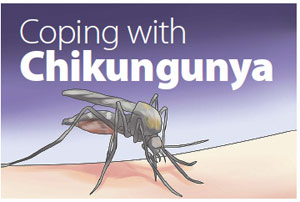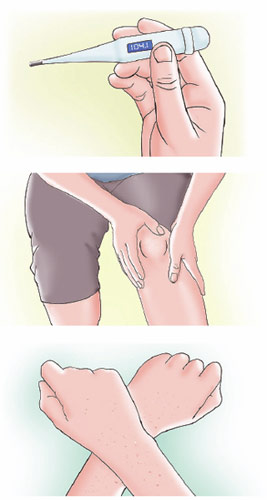 |
 |
 |
|
February 2015 |
Chikungunya is a virus, transmitted to humans through the bite of an infected mosquito. There is no medication on the market to fight this virus; instead, you address the symptoms and your body fights off the virus over time. The virus affects groups of all ages, of both genders, and has an incubation period of three to twelve days. The disease has a severe and aggressive onset. The acute stage of the disease is followed by the chronic phase, in which the symptoms are exacerbated; 15% of infected people develop chronic symptoms. The virus has gone through a mutation in recent times, meaning that its replication and transmission have been facilitated. The virus (CHIKV) causes a self-limiting disease. This means that it will resolve itself without any specific treatment. Mortality among Chikungunya sufferers is very rare, and is mostly due to complications.
SYMPTOMS
Fever. Fever may be low or high grade. It first rises for the first 24 to 48 hours, returns to normal temperature, and rises back to above-normal levels even up to 40°C (104°F) after being afebrile for a day or two. Circulatory collapses can occur in this phase. Fever returns to normal within two weeks. Joint pains. Joint pains are severe in character, migratory, tend to be worse during mornings and after longer immobility, are relieved by light exercise, but worsened by strenuous and aggressive movements. Joint pains occur immediately after or at the same time as the fever. Joints usually involved are the wrists, ankles, knees, and elbows, small joints of the hands and feet, and sometimes, the shoulders and hips. Pre-altered joints are often more affected. The pain sometimes seems to originate from the insertions of tendons. Skin rash. Skin rash occurs in half of patients with Chikungunya. Skin rash consists of small reddish spots or bumps (maculopapular) but may be vesicles and/or blisters. This rash appears two days to five days after the fever. The rash usually occurs on the trunk, legs, soles, palms, and face. Other symptoms include headache, nausea, vomiting, inflammation of the conjunctiva of the eyes (conjunctivitis), back pain, diarrhea, and sores or ulcers of the tongue and/or mouth. The subacute phase. The subacute phase of Chikungunya occurs from one to three months after the acute phase of illness ends. During the subacute phase, the main symptom is arthritis. Aside from this, disorders of blood vessels like Raynaud’s phenomenon can occur. Raynaud’s phenomenon is a condition where there is decreased blood flow to the hands and feet in response to cold or emotional stress. The chronic phase. The chronic phase of Chikungunya occurs beyond three months and persists even up to two to three years. The main symptom of this stage is prolonged and severe arthritis, fatigue, depression, and body weakness. Persistent joint pains occur in Chikungunya patients who are 45 years old or older, with severe joint pains at the onset, and with existing osteoarthritis even before the start of the Chikungunya illness. The subacute and chronic phase occurs in 13% of patients with Chikungunya. The disease can be asymptomatic. However, it is not yet known how commonly this happens. What’s more, it lasts for days in some and months in others. In severe cases, arthritis or joint pain can incapacitate patients for months. Also in some cases, patients suffer from skin manifestations such as scaling, excoriated lesions on the skin, itching, and red spots on the skin surface. Eye redness and the difficulty of looking at bright light are also documented. See a doctor and get the disease diagnosed. Chikungunya is diagnosed with the help of the ELISA blood test. This test uses antibodies and enzymes to detect the presence of the pathogen agent. This is the most effective way in diagnosing the disease, because all the other symptoms are very similar to other common illnesses. The diagnosis is positive when joint pain and fever are seen along with other test results. First of all, virus isolation is performed. The procedure lasts about two weeks and must be carried out in high level biosafety laboratories. The procedure consists in exposing certain cell lines to blood samples. The specific virus responses are then identified. The RT-PCR (Reverse transcription polymerase chain reaction) is a test used to detect the virus. The technique amplifies a range of Chikungunya genes present in the blood, highlighting them during the microscopic exam. The time needed for the results is about two or three days. TREATING THE SYMPTOMS There is no specific cure or treatment for Chikungunya. All one can do is treat the symptoms. Currently, there is no antiviral drug to fight against the Chikungunya virus. Treat the fever. Fever is described as a temperature of 37.80°C (100.4°F) or higher. What is usually given is Paracetamol at 500 mg per tablet every 4 to 6 hours for adults if febrile. Paracetamol for children is given at 10mgs per kg of body weight every 4 hours to 6 hours if febrile. Ask for a prescription for Paracetamol from your physician. Do not take medicines on your own. Aside from Paracetamol, do sponge bathing until the temperature returns to normal. Use tap water and not ice water for sponge baths because rebound return of fever tends to be higher immediately after using ice water. Treat the joint pains or arthritis with pain relievers prescribed by your physician. Joint pains due to Chikungunya during the acute phase of illness can be relieved by taking tablets of non-steroidal anti-inflammatory drugs, a group of pain relievers stronger in effect than Paracetamol. (Reproduced from http://m.wikihow.com/Recover-from-Chikungunya) Tell the Insect Vector Control DivisionThe Ministry of Health’s website urges citizens “to inform the Insect Vector Control Division (612-IVCD/4823) if either you or a relative has been diagnosed with Chikungunya or Dengue fever by a physician.” |



 The symptoms cover three phases, but most patients experience only the acute phase, with symptoms lasting anywhere from 3-12 days. Thereafter, the illness disappears in 87% of cases, as the body’s immune system eventually fights it off, like any cough or cold. But during this period, symptoms may be as follows:
The symptoms cover three phases, but most patients experience only the acute phase, with symptoms lasting anywhere from 3-12 days. Thereafter, the illness disappears in 87% of cases, as the body’s immune system eventually fights it off, like any cough or cold. But during this period, symptoms may be as follows: